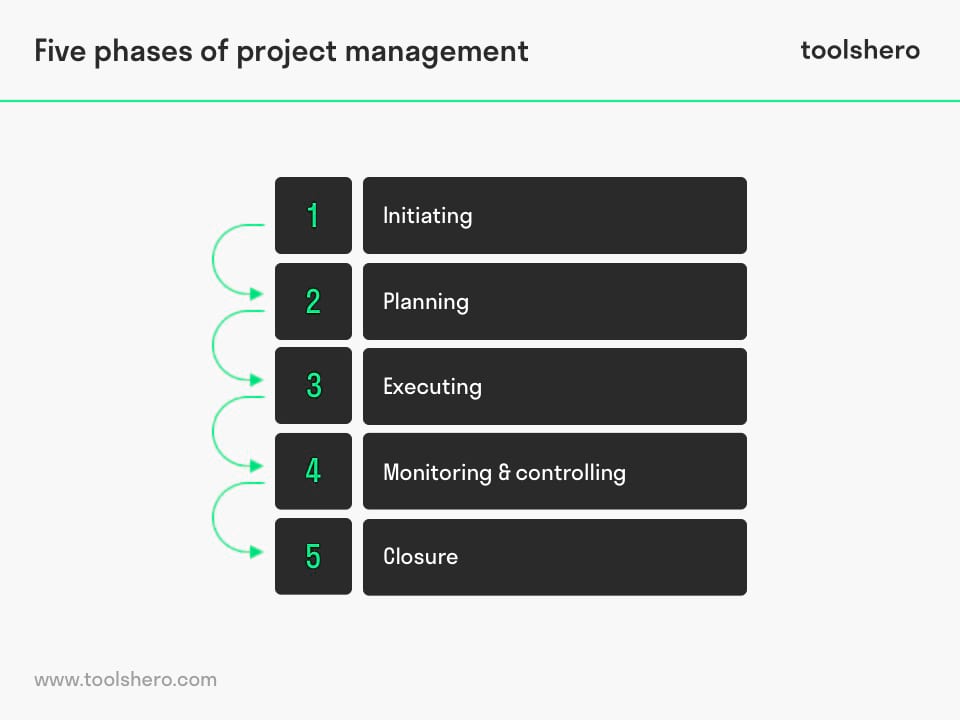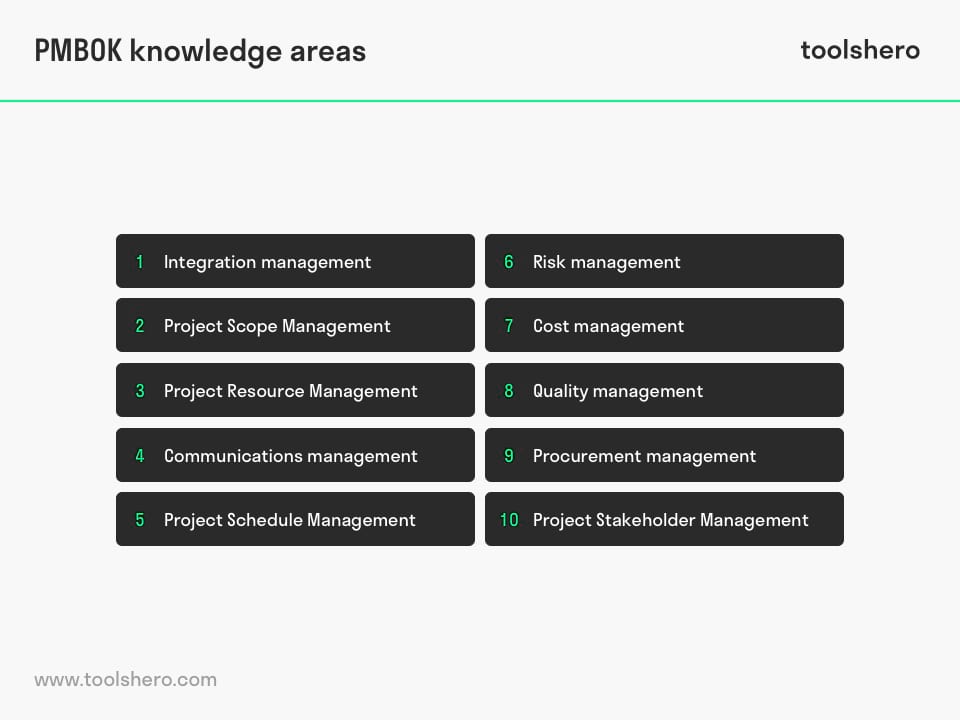PMBOK explained including guide

PMBOK: This article provides a practical explanation of PMBOK. In addition to explaining what it is, this article also explains why you should use it, its structure, the 5 phases of project management and the 49 processes. After reading it you will understand the basics of this project management method. Have fun reading!
What is PMBOK?
PMBOK stands for Project Management Body of Knowledge and is a collection of guidelines, terminology, and best practices that are accepted as standards for project management.
PMBOK is managed by the Project Management Institute. It contains many processes and techniques from project management and, since the amount of knowledge is also always growing, is constantly being expanded and updated.
PMBOK is not a project methodology; there’s no such thing as a PMBOK project. Instead PMBOK can be used to create a universal language for everyone working in project management. Compared to other waterfall methods, PMBOK is most closely related to PRINCE2.
PMBOK is managed by the Project Management Institute (PMI). The PMI was founded by five volunteers in 1969.
In 1996 the first edition of the PMBOK guide was presented to the public. The goal was to set a standard for project management. For that they researched the way in which projects are managed and improved.
Since the introduction of the PMBOK guide, the PMI has been recognised as an accredited standard developer by the American National Standards Institute (ANSI).
Why use PMBOK?
PMBOK is used as a standard through which a PMP certificate can be obtained. The main advantage of a PMP certificate is that project managers and team members, as well as other resources will already have been trained and prepared for work in project management.
PMBOK enables businesses to standardise projects across different departments. This means employees in the marketing department will use the same approach for a project as those working in the finance department.
The project management guide also helps project managers. Because the project management approach is universal in companies that use PMBOK, managers can more easily change companies without needing long periods to gain knowledge.
Project Management Body of Knowledge discusses and explains what works and what doesn’t work in practice. This prevents large-scale failures of projects.
Structure
There is a wide range of different project types. They all consist of different processes and knowledge areas. PMBOK is process oriented. This means that the project is described as a process that has to be carried out. In the guide, the entire project is split into three:
- Input, such as documents, decisions, plans, designs etc.
- Techniques and methods
- Output such as documents, decisions, plans, designs etc.
The manual provides the user with a project management life cycle consisting of 49 processes. These processes fall under one of the five basic process groups. Basic process groups are activities or actions that are typical for most projects. These processes may overlap and are sometimes interdependent.
Five phases of project management
The 49 processes, which cover the entire project, are split into five phases and include everything the user has to do.

Figure 1 – The 5 phases of project management via PMBOK
1. Initiating
The processes in the initiating phase help the user define a new project. The processes in this area ensure that something is created that can subsequently be expanded upon. During this phase, the project gets formal authorisation from the sponsor and stakeholders.
2. Planning
PMBOK defines 24 processes related to planning. This makes planning the most extensive phase. Although the project team can choose which processes it uses, it’s clear that there is a strong focus on planning in project management.
The processes in the planning phase help the user define objectives and create an overview of the work that has to be done.
3. Executing
This is the phase where the team starts working on the deliverables. The project manager coordinates the team and assigns the right resources to the right people and tasks. Processes in the execution phase also include communication and involving stakeholders. The project manager safeguards the quality of the project and deliverables during this phase as well.
4. Monitoring & controlling
This phase of the project actually applies to the entire project cycle. Monitoring and controlling means tracking, evaluating, and reporting the work that’s being done. According to PMBOK, these are ‘processes that are necessary to monitor, evaluate, and control the progress and performance of a project, identifying all the areas in the plan that require changes, and initiating those changes.’
Examples of activities in this phase are managing costs, scheduling, and the focus on scope.
5. Closure
When it’s time to conclude the project, the processes in the last phase are used to complete other process groups mentioned above. The project will be formally concluded here. There will be room for approval, acceptance, and rewards in the case of positive results. In general the project manager closes a project by archiving documents, organising a closing meeting, and releasing the team.
10 knowledge areas and 49 processes
All the process described above cannot be carried out without knowledge. All the required knowledge can be traced back to ten knowledge areas according to the PMBOK guide. There are twice as many knowledge areas as process types. The knowledge areas tell the user what they should know.

figure 2 – The PMBOK knowledge areas
Project in 49 steps
Below follows an explanation of all knowledge areas with their accompanying processes.
Integration management
These processes are necessary to ensure that the different elements of the project are coordinated properly
- Develop project charter
- Develop project management plan
- Manage project deliverables
- Manage project knowledge
- Monitor and manage project results
- Implement integrated change management
- Closing phase or project
Project Scope Management
These processes are required to ensure that the project contains the necessary work to be able to successfully complete the project.
- Plan project scope
- Collect requirements
- Define scope
- Create a work-breakdown structure
- Validate scope
- Manage scope
Project Resource Management
These processes relate to the factors that organise, manage, and lead the project team.
- Plan resource management
- Calculate the necessary resources
- Gather the necessary resources
- Develop the team
- Manage the team
- Manage the resources
PMBOK: Communications management
This refers to all process that are necessary to ensure that project information is handled in the right way. Think for instance of collecting, creating, distributing, storing, managing, monitoring, and depositing information.
- Communications management plan
- Manage communication
- Monitor communication
PMBOK and Project Schedule Management
The processes in this knowledge area are necessary to complete the project in time and to guarantee deliverables.
- Plan schedule management
- Define activities
- Apply sequence
- Calculate duration of activities
- Develop a schedule
- Manage the schedule
PMBOK: Risk management
The processes of risk management consist of processes aimed at: planning, identifying, analysing, managing counter actions. Read more about risk management.
- Risk management plan
- Identify risks
- Conduct qualitative risk analysis
- Conduct quantitative risk analysis
- Plan risk responses
- Implement risk responses
- Monitor risks
PMBOK: Cost management
These are the processes in PMBOK that are necessary to ensure that the project stays within the approved budget.
- Cost management plan
- Estimate the costs
- Create a budget
- Manage costs
Quality management
The processes of the project quality management knowledge area relate to quality policy, objectives, and responsibilities.
- Quality management plan
- Manage quality
- Control quality
Procurement management
This knowledge area includes all processes necessary to achieve results with products and services. Processes in this area are about procurement planning, recruitment, selection, and relationship management. Procurement is an important part of supply chain management. Processes included here are:
- Procurement management plan
- Conduct procurement
- Manage procurement activities
PMBOK and Project Stakeholder Management
Processes in this knowledge area of PMBOK are necessary for identifying and involving all people and organisations who have a stake in the project.
- Identify stakeholders
- Plan stakeholder involvement
- Manage stakeholder involvement
- Monitor stakeholder involvement
Now it’s your turn
What do you think? Are you familiar with the explanation of PMBOK? Is PMBOK used in your work environment? Would you be able to use the 49 steps for carrying out projects? Do you have any tips or additional comments?
Share your experience and knowledge in the comments box below.
More information
- Guide, A. (2001). Project management body of knowledge (pmbok® guide). In Project Management Institute.
- Wideman, R. M. (2002). Comparing PRINCE2® with PMBoK®. AEW Services, Vancouver, BC, Canada.
- Reich, B. H., & Wee, S. Y. (2006). Searching for Knowledge in the PMBOK® Guide. Project Management Journal, 37(2), 11-26.
- Rose, K. H. (2013). A Guide to the Project Management Body of Knowledge (PMBOK® Guide)—Fifth Edition. Project management journal, 44(3), e1-e1.
How to cite this article:
Janse, B. (2019). PMBOK (Project Management Body of Knowledge). Retrieved [insert date] from Toolshero: https://www.toolshero.com/project-management/pmbok/
Original publication date: 12/22/2019 | Last update: 05/12/2023
Add a link to this page on your website:
<a href=”https://www.toolshero.com/project-management/pmbok/”>Toolshero: PMBOK (Project Management Body of Knowledge)</a>












